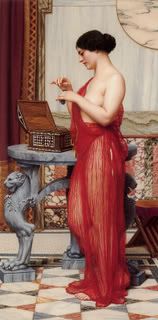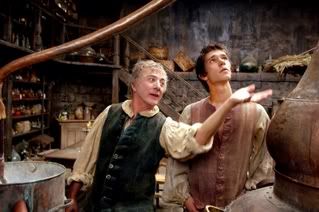
After examining the properties and usage of jasmine in perfumery it was about time to concentrate on specific perfumes that feature it in its multiple capacities. To this end, it was decided that a triplet of divisions would be opted for: rich essences with depth and oomph, mellow compositions that stand on the golden medium between extremes and fresh nuances that are welcome even on the hottest of days and would never overwhelm. Today we are focusing on the first category.
The crown jewel is of course A la nuit by Serge Lutens. However it has been adequately elaborated on at Perfume Shrine not to require further description.
On the same rich and abundant jasmine kick, L'artisan Parfumeur makes the surprise and offers us a heady bouquet in La Haie Fleuri de Hameau. It is big, opulent, operatic and orgasmic even, full of the concentrated essence of jasmine, much like A la nuit is. Created as a haunting interpretation of Marie Antoinette's garden of white flowers at Versailles by Jean La Porte, founder of L'artisan house and subsequently creator of the Maitre Parfumeur et Gantier line, it is reminiscent of A la nuit's opulence minus the heavy indolic rot.
However La haie fleuri is encompassing other floral notes as well, such as pronounced hyacinth in the drydown as well as lily of the valley and honeysuckle at the opening with a smidgeon of tuberose (subdued) that account for a multi-floral impression that like an impressionistic painting stuns you with its brutal exploitation of the light and its effects on objects. The different nuances with a little green and a little soap interjected peek through at intervals and make their presence known all the while under the baguette of the efficient maestro that jasmine undoubtedly is. Very potent and surprisingly extremely lasting (and I am saying this for those who complain on L'artisan's offerings' lasting power), it is to be used with restraint.
Although created some time ago, it still is available at the Boutique L'artisan and at select places where the brand is available in the big 100ml bottle only. Check here for prices and availability.
Jardin Blanc by Maitre Parfumer et Gantier was the next logical step in our itinerary through rich hedonistic jasmines, and not only for reasons of symmetry after La Haie Fleuri. The inclusion of tuberose shifts this one in the fecal, animalic direction when the opening slaps you across the face with its audacity and insolence, with what smells to my nose as sweet heady honeysuckle and with a nod to Fracas with its rubbery heart.
The official notes are, according to Aedes:
Top: Mandarin, myrtle, leafy green; Middle: Ylang-ylang, clove, jasmine; Base: Sandalwood, tolu, vetiver.
It doesn't come off as green or leafy, although there is the weird "freshness" that white florals sometimes possess at the initial stage, as if you have cut the stems from the vine just now, yet it is deeply earthy, sweet and potent, drying down softer, soapier and more muted which accounts for higher wearability than initially expected.
The Different Company under the direction of Jean Claude Ellena's daughter, Celine Ellena, came out with Jasmin de Nuit, an offering that could not leave Perfume Shrine and its love of all things jasmine uninterested. The official notes include bergamot, black currant, egyptian jasmine, star anise, cinnamon, cardamom, sandalwood, musk and amber. According to the house, it has unusually high concentrations of Egyptian jasmine absolute, which is a variety that supposedly has a fruitier undertone than others more commonly used.
My personal impression is that it is more spicy than intensly floral on the whole and as such it cannot but be a very intriguing addition to the sampling package of any discerning perfume afficionado in the search for jasmine perfumes. In fact many spice lovers would find the cardamom opening delectable (which is a favourite spice for the Ellena family, if I go by Jean Claude's magnificent pilgrimage to it in Declaration by Cartier). It then mellows and leaves the jasmine notes to marry with ambery undertones that linger seductively and warmly on the skin for a long time, much more than other creations of The Different Company if you're familiar with the line.
In our perusal of rich jasmine fragrances, Creed with its Jasmine Emperatrice Eugenie, a fragrance created for a real historical figure, is next on our list. Based on an original formula of the 19th century for the wife of Napoleon III, it is a triumph for the house of Creed. With its rich, suave sandalwood base and its effluvium of jasmine it is at once feminine and emancipated enough to command attention. The lightly vanillic base accounts for augmenting the warmth and cuddliness of the scent. Its character lies somewhere between Bois des Iles by Chanel, Samsara by Guerlain and Organza by Givenchy, accounting for a woody floral that is elegant yet potent at the same time.
Samsara by Guerlain is another stonking beat of jasmine with the rich support of sandalwood, amplified to the max. If your olfactory nerve does not numb with the potent smell I don't know what will produce such an effect. Still, it is a modern classic that merits testing. For a lovely detailed review of it, you can browse Ayala's review here
And for the grand finale, Jasmin Full by Montale is a lethal Venus flytrap that is certainly going to entangle you into a deathly grip. Very strong, yet not indolic or animalic the way A la nuit is, it lasts extremely well and lets its other floral notes like orange blossom peek a boo for the merest whiff. It has been commented to smell a little like ammonia, which could be attributed to the nature of jasmine molecular structure and emition as discussed before, still I do not perceive it as unpleasant, which is something I cannot say for some of the oudhs on the Montale line which compete for foulest sniff on my personal fragrance path. A must try for serious jasmine fans.
Next post will focus on mellow, balanced jasmine renditions.
Artwork Flaming June by Frederick Leighton courtesy of artcom.
.jpg)













